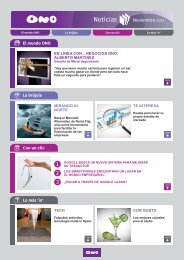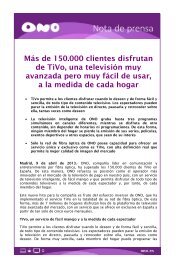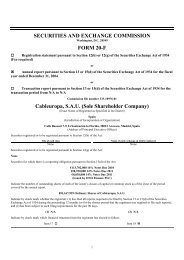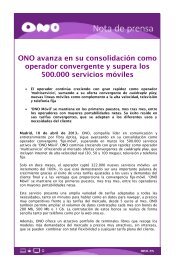USER'S GUIDE - Ono
USER'S GUIDE - Ono
USER'S GUIDE - Ono
You also want an ePaper? Increase the reach of your titles
YUMPU automatically turns print PDFs into web optimized ePapers that Google loves.
HITRON CDE-30364 USER’S <strong>GUIDE</strong><br />
29<br />
When the CDE-30364 is not in routing mode, the service provider assigns an IP<br />
address to each computer connected to the CDE-30364 directly. The CDE-30364<br />
does not perform any routing operations, and traffic flows between the computers and<br />
the service provider.<br />
Routing mode is not user-configurable; it is specified by the service provider in the<br />
CDE-30364’s configuration file.<br />
2.1.7 CONFIGURATION FILES<br />
The CDE-30364’s configuration (or config) file is a document that the CDE-30364<br />
obtains automatically over the Internet from the service provider’s server, which<br />
specifies the settings that the CDE-30364 should use. It contains a variety of settings<br />
that are not present in the user-configurable Graphical User Interface (GUI) and can<br />
be specified only by the service provider.<br />
2.1.8 DOWNSTREAM AND UPSTREAM TRANSMISSIONS<br />
The terms “downstream” and “upstream” refer to data traffic flows, and indicate the<br />
direction in which the traffic is traveling. “Downstream” refers to traffic from the<br />
service provider to the CDE-30364, and “upstream” refers to traffic from the CDE-<br />
30364 to the service provider.<br />
2.1.9 CABLE FREQUENCIES<br />
Just like radio transmissions, data transmissions over the cable network must exist<br />
on different frequencies in order to avoid interference between signals.<br />
The data traffic band is separate from the TV band, and each data channel is<br />
separate from other data channels.<br />
2.1.10 MODULATION<br />
Transmissions over the cable network are based on a strong, high frequency periodic<br />
waveform known as the “carrier wave.” This carrier wave is so called because it<br />
“carries” the data signal. The data signal itself is defined by variations in the carrier<br />
wave. The process of varying the carrier wave (in order to carry data signal<br />
information) is known as “modulation.” The data signal is thus known as the<br />
“modulating signal.”<br />
Cable transmissions use a variety of methods to perform modulation (and the<br />
“decoding” of the received signal, or “demodulation”). The modulation methods<br />
defined in DOCSIS 3 are as follows:<br />
QPSK: Quadrature Phase-Shift Keying<br />
QAM: Quadrature Amplitude Modulation<br />
QAM TCM: Trellis modulated Quadrature Amplitude Modulation<br />
CABLE

















